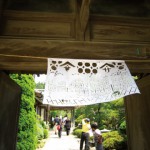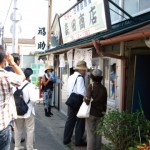生きる博覧会とは?
2010年夏に南三陸町志津川地区で、町のみなさんとともにアートプロジェクトを行いました。
JR志津川駅から海のそばのおさかな通りの約1キロの沿道の家々の軒先に、白い切り紙を約650枚飾ったのです。沿道の家や店を取材してそれぞれの物語や歴史を、伝統的な神棚飾り「きりこ」の様式を真似て切り紙にしたのです。
きりこプロジェクトは、町に存在するさまざまな物語を可視化し、携わった町の女性たちや町の人たちとのコミュニケーションを活性化しました。女性たちは町の産業振興課と協働しながら、新たなまちの魅力を創り出すべく、「アジアン・デイ」の開催やスイーツの開発など、活発に活動し始めました。2011年2月2日、町長はじめ140人の町民を前に半年間の活動について報告しました。来年度さらなる発展的活動を誓い合った40日後、その町は東日本大震災の大津波により、丸ごと消えてしまいました。
町全体の70%の建物が流失した南三陸町。店も工場も会社も公共施設もあらゆるものが一瞬のうちになくなり、わずかに残った建物の残骸の解体も始まりました。
みんなの思い出のよりどころがどんどん消えていく町で、人々は依然として展望が開けない『仮』の生活をおくっています。

 南三陸町の人々の心の中に生きている町の姿、時間が育んできたもの、地域固有の文化を決してなくしてしまうことがないように、そして復興に際して、それらに基づいた新しい価値を産み出しながら町の再興に向かえるように、ささやかながら活動を続けています。
南三陸町の人々の心の中に生きている町の姿、時間が育んできたもの、地域固有の文化を決してなくしてしまうことがないように、そして復興に際して、それらに基づいた新しい価値を産み出しながら町の再興に向かえるように、ささやかながら活動を続けています。
皆様方の有形無形のあたたかいご支援に、心から御礼申し上げます。被災地のみなさんは、この苦境にも負けずがんばっていらっしゃいますが、これから苦しい山をいくつも越えなければなりません。ENVISIは、南三陸町のみなさんの心のよりどころを創出し続けるべく、活動してまいります。
The EXPO of Living 2012
In 2010, in collaboration with the residents of Minamisanriku, we organized an art project, in which we exhibited “Kiriko” – paper cutting craft of white paper – in front of the shops and houses along a 1km-long street that goes from the station to the “Osakana-dori” by the sea. Each work represented history and story of the house owner.
This project stimulated interaction among residents and shop owners of the town, making the stories of the community visible. After participating in the project, the women started to work spontaneously to make the town more attractive place, cooperating with the Industry Promotion Section of the town hall. Forty days after the briefing session of their activities for the latter half of the year, the whole town disappeared.
In the town of Minamisanriku, 70% of the buildings were swept away. Everything vanished in an instant – homes, stores, schools, factories, companies, public facilities… Even the remains of the buildings that survived the tsunami are now being demolished.
The residents are still forced to accept “temporary” lives with no prospects for the future, while places of their fond memories are disappearing one after another.
Image of the town still vivid in people’s memories, things that have been nurtured by time and culture that is specific to the area – are things we are working to keep alive, at the same time trying to make these elements foundation for rebuilding with new values.
We are deeply grateful to all the support, tangible or intangible, we have received. Without it, we couldn’t have achieved what we have done so far.
As the long road for rebuilding has barely started in affected areas, nothing will be more appreciated than your continuous support.
Please refer to “Wochi Kochi Magazine” of The Japan Foundation, to which we contributed a report, for our activities in 2011.
http://www.wochikochi.jp/special/2012/04/minamisanriku.php














